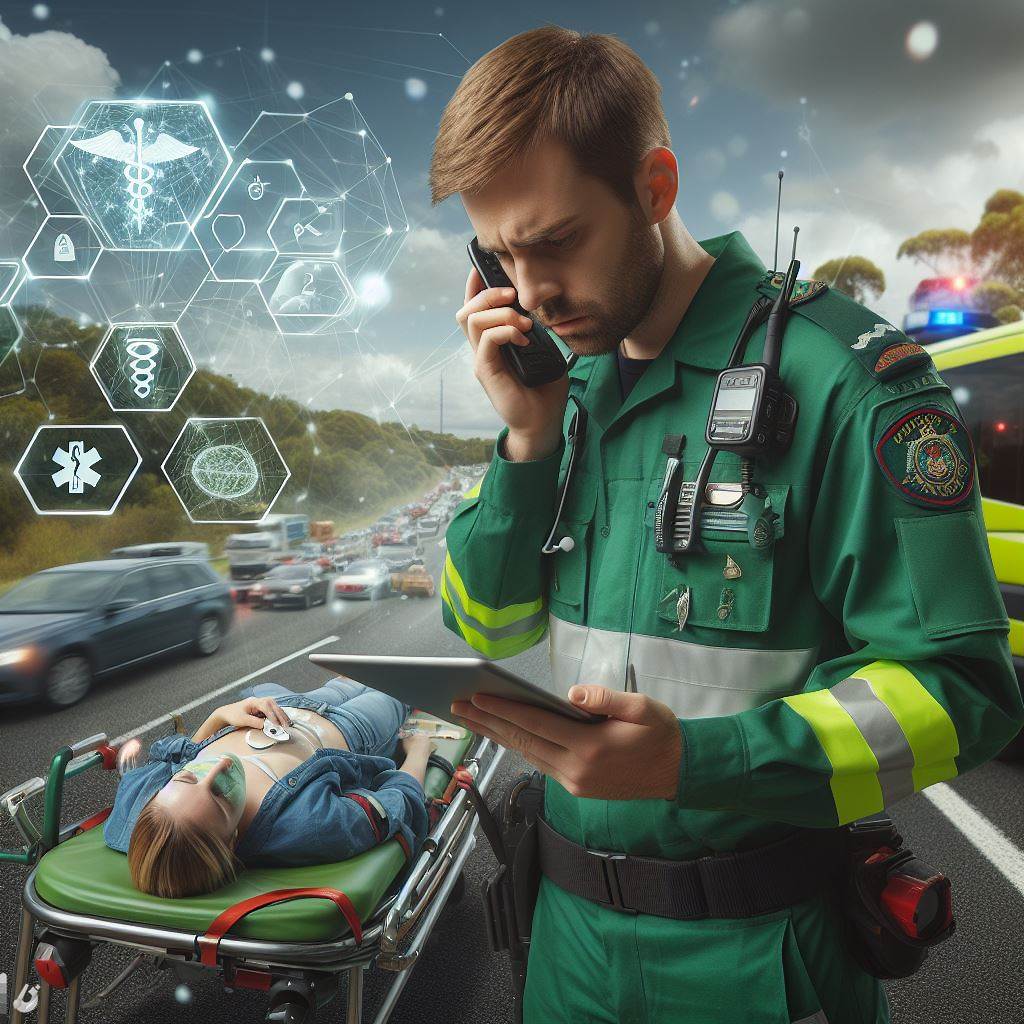Introduction
In emergencies, time is critical. It’s not just about being present; it’s about knowing what to do. Basic first aid skills are a powerful tool, more than mere instructions—they save lives.
Imagine a scenario where someone urgently needs medical attention. Would you freeze or take confident, life-saving action?
Knowing basic first aid is crucial, making a swift and educated response the difference between a positive outcome and a tragedy.
The upcoming sections guide you through the insights of Aussie paramedics, professionals on emergency frontlines.
Their wealth of experience is distilled into practical tips. From fundamental CPR to adept wound care, these paramedic-approved strategies empower you to handle unforeseen situations with poise.
Emergencies don’t wait for a convenient moment; they demand quick thinking and immediate action.
This blog equips you with knowledge crucial in critical moments, aiming to make you a first aid hero in your community.
Invest time in learning first aid not just for the worst moments but to actively contribute to a safer society. By the series’ end, you’ll have life-saving skills and the confidence to use them effectively.
Sections explore intricacies of various first aid scenarios, offering step-by-step guidance from daily experts. Insights go beyond basics, providing a comprehensive understanding of first aid principles.
Your commitment could mean the difference between chaos and calm, despair and hope. Join this journey to empower yourself and others with knowledge that makes a real difference in adversity.
General First Aid Tips
Remaining calm and composed during a medical emergency
In any medical emergency, remaining calm and composed is crucial. Panicking only worsens the situation and hampers decision-making abilities.
By staying calm, you can think more rationally and act appropriately, which is vital when providing first aid.
Assessing the situation and ensuring personal safety before providing first aid
Assessing the situation before jumping into action is equally important. Analyze the surroundings to ensure your personal safety before attending to the injured person.
For instance, if there is a risk of falling debris or ongoing danger, it is crucial to move to a safe area first.
Calling emergency services and providing accurate information
When calling emergency services, provide accurate information to ensure a prompt and effective response. Clearly communicate the nature of the emergency and the exact location, including landmarks if possible.
This helps emergency responders to reach the scene quickly and with the necessary resources.
Knowing the basic first-aid techniques
Possessing basic first aid skills is vital. CPR and the Heimlich maneuver increase survival chances. Certified training empowers immediate assistance until professional help arrives.
Control severe bleeding by applying direct pressure with a clean cloth. Elevate the injured part above the heart level to aid in bleeding control.
Handle fractures by immobilizing with a splint before seeking medical assistance. Treat sprains with ice and compression to reduce swelling and alleviate pain.
Cool burns immediately with running cold water for at least ten minutes. Basic first aid knowledge is crucial but not a substitute for professional medical care.
Seek medical help promptly, even after administering initial first aid. Stay updated with first aid techniques through refresher courses for effective care during emergencies.
Remain calm, assess the situation, call emergency services with accurate information, and know basic first aid techniques.
These skills significantly impact saving lives and minimizing harm during medical emergencies. Continuous learning and staying updated ensure effective first aid assistance when needed.
Read: Rural Medicine in Australia: A Closer Look
First Aid for Common Injuries
Steps to be taken in case of minor cuts, burns, and scalds
- Clean the wound gently with clean water and mild soap to prevent infection.
- Apply direct pressure using a clean cloth or bandage to stop bleeding.
- For burns, run cool (not cold) water over the affected area for at least 10 minutes.
- Cover the wound with a sterile adhesive dressing or clean cloth to protect it.
- Seek medical attention if the wound is deep, large, or shows signs of infection.
Tips on proper wound cleaning and dressing techniques
- Wash hands thoroughly before treating a wound to avoid introducing bacteria.
- Use sterile gloves and clean tools to minimize the risk of contamination.
- Clean the wound with running water or saline solution to remove dirt and debris.
- Apply an antiseptic solution or ointment to prevent infection.
- Cover the wound with a sterile dressing, ensuring it is the appropriate size and securely fixed.
The appropriate approach when dealing with sprains, strains, and fractures
- For sprains and strains, use the R.I.C.E method: Rest, Ice, Compression, Elevation.
- Rest the injured area, apply ice for 20 minutes every 2-3 hours, and compress it with an elastic bandage.
- Elevate the injured limb to reduce swelling.
- Support fractures by immobilizing the injured area with a splint or sling.
- Seek medical help for proper diagnosis, treatment, and potential X-rays.
Recognizing and responding to allergic reactions and anaphylaxis
- Look out for symptoms such as hives, swelling, itching, difficulty breathing, or dizziness.
- If someone is experiencing anaphylaxis, call emergency services immediately.
- Help the person self-administer their prescribed epinephrine auto-injector, if available.
- Lay the person flat and elevate their legs to improve blood flow.
- Monitor their vital signs until medical professionals arrive.
Read: Work-Life Balance for Aussie Doctors
First Aid for Specific Emergencies
Handling a Choking Victim and Performing the Heimlich Maneuver
- If someone is choking, stand behind them and place your arms around their waist.
- Make a fist with one hand and place it just above their navel.
- Grasp your fist with your other hand and forcefully thrust upwards into their abdomen.
- Continue performing abdominal thrusts until the object is dislodged or the person becomes unconscious.
Providing First Aid for a Heart Attack or Stroke
- If someone is experiencing chest pain and difficulty breathing, suspect a heart attack.
- Call emergency services immediately and keep the person calm.
- Have them chew and swallow one adult-sized aspirin if not allergic.
- If someone shows signs of stroke (facial drooping, arm weakness, slurred speech), call for help immediately.
- Keep the person lying down with their head slightly elevated.
Actions to Take in Case of a Seizure or Unconsciousness
- If someone has a seizure, make sure they are in a safe place and remove any objects that may injure them.
- Time the duration of the seizure and stay with the person until it ends.
- Do not restrain them or put anything in their mouth.
- After the seizure, place them in a recovery position to prevent choking on saliva or vomit.
- If someone is unconscious but breathing, place them in the recovery position and monitor their breathing.
Providing First Aid in Cases of Poisoning or Overdose
- If someone has ingested a harmful substance, immediately call emergency services or poison control.
- Do not induce vomiting unless instructed by a medical professional.
- Try to identify the substance and provide this information to the emergency responders.
- If someone overdoses on drugs, try to keep them calm and awake until medical help arrives.
- Do not leave them alone and be prepared to provide CPR if needed until help arrives.
Remember, these first aid tips are meant to provide initial assistance until professional help arrives. It is crucial to seek medical attention as soon as possible in all emergency situations.
By being prepared and knowledgeable about first aid techniques, you can make a difference and potentially save a life.
Read: Salaries of Doctors in Australia Unveiled
Your Personalized Career Strategy
Unlock your potential with tailored career consulting. Get clear, actionable steps designed for your success. Start now!
Get Started
You Might Also Like: Surgeon Burnout: Addressing the Issue
Importance of First Aid Training
When it comes to emergency situations, having proper first aid training can make all the difference.
Benefits of Proper First Aid Training
- Increased knowledge and skills in providing immediate medical assistance to those in need.
- Improved ability to assess the situation and take appropriate action before professional help arrives.
- Reduced risk of worsening injuries or complications by providing correct and timely first aid.
- Enhanced confidence in handling emergency situations, leading to effective and efficient response.
- Increased chances of saving lives and preventing further harm in critical situations.
- Opportunity to become a valuable asset within your community by being trained to save lives.
Possessing first aid knowledge and skills benefits both the individual receiving immediate care and promotes a sense of security and peace of mind for the first aid provider.
The confidence and peace of mind that comes with knowing how to provide first aid
Imagine being at a family gathering or out in public when someone suddenly collapses. With proper first aid training:
- You would know how to quickly and accurately assess the person’s condition.
- You would be confident in performing CPR, if necessary, until professional help arrives.
- You would be able to control bleeding and prevent further harm until medical assistance is available.
- You would have the skills to stabilize fractures and provide support until emergency services arrive.
First aid training not only equips you with the knowledge and skills necessary to handle emergencies effectively but also provides you with the confidence to take action.
Available First Aid Training Programs in Australia
Australia offers a wide range of first aid training programs catering to different levels of expertise and interests. Some reputable organizations providing first aid training include:
- Australian Red Cross
- St. John Ambulance
- Royal Life Saving Society – Australia
- Australian Resuscitation Council
These organizations offer comprehensive first aid courses, including CPR, advanced resuscitation, and specific training for childcare providers and workplace first aiders.
Enroll in a First Aid Course Now
If you haven’t already, consider enrolling in a first aid course to become more prepared and capable in handling emergencies.
The skills and knowledge gained from these courses can be invaluable in various situations, from minor injuries to life-threatening emergencies.
By enrolling in a first aid course, you contribute to building a safer and more resilient community.
Remember, emergencies can happen at any time, and the ability to provide immediate assistance can truly be a lifesaver.
Take the initiative to learn first aid, and empower yourself with the ability to make a difference when it matters most.
Read: Australian Medical Exams: What to Expect
Learn More: Women in Public Health: Australia’s View
Stand Out with a Resume That Gets Results
Your career is worth more than a generic template. Let us craft a resume and cover letter that showcase your unique strengths and help you secure that dream job.
Get HiredFind Out More: Overseas Nurses: Working in Australia
Conclusion
In the end, this blog post has highlighted several crucial first aid tips from Aussie paramedic experts.
It is evident that having basic first aid knowledge and skills can make a significant difference in emergency situations. By being proactive and prepared, individuals can potentially save lives.
It is important to remember the key points discussed, such as performing CPR correctly, applying pressure to bleeding wounds, and keeping calm in stressful situations.
These simple actions can make a profound impact on the outcome of an emergency.
We strongly encourage readers to share this blog post with their friends and family. Increasing awareness about first aid is vital, as it empowers more people to be prepared in emergencies and potentially save lives.
We urge you to prioritize learning first aid. Take the time to acquire the necessary skills and knowledge. Sign up for a first aid class or enroll in an online course.
Remember, being prepared can make all the difference when faced with an emergency situation.
Spread the word and help create a community of individuals who are proactive in emergency situations. Together, we can make a difference and save lives.




